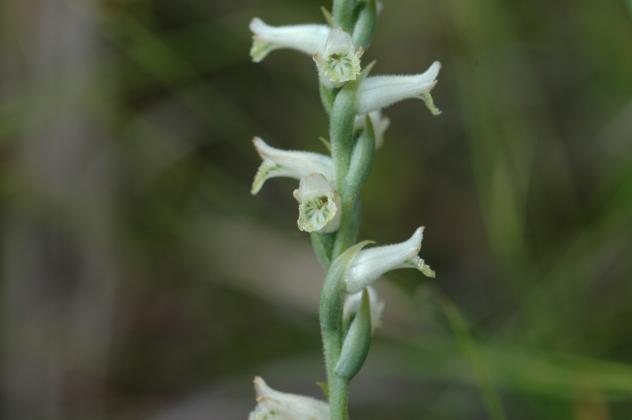Spiranthes parksii - Brazos Valley's endangered orchid
Spiranthes parksii, Navasota lady's tresses, NLT, is a wild orchid that is endemic to Texas. Endemic means that a species is unique to a defined geographic location. About one foot tall, it has a thin stem with leaves mainly near the ground. They may disappear when the off-white flowers appear. Flowers spiral around the stem and have a green stripe that runs down the middle of some petals. The genus name Spiranthes is from the Greek speira, coil and anthos, flower. Nectar attracts pollinators, but the plant is capable of self-pollination.
First discovered in 1945, NLT was listed as an endangered species by the U.S. Fish and Wildlife Service, USFWS, in 1982. At that time, it was found mainly in the Brazos Valley. Since then, biologists have identified it in surrounding counties. But many feel the orchid's numbers are falling due to urban and industrial development. Texas A&M University has a paper, "Navasota ladies’ tresses (Spiranthes parksii Correll) An Endangered Terrestrial Orchid of Texas". It has information about NLT and discusses other possible reasons for its decline which include soil nutrients and root disturbance by feral pigs. The report is at agrilifecdn.tamu.edu.
There is controversy about whether or not the plant should be on the endangered species list. Some landowners have been prevented from proceeding with certain projects because they would disturb NLT's habitat. There are procedures that must be followed in order for a plant or animal to be considered endangered and for it to be removed from the endangered list. It has been difficult to count NLT because it blends into the grass and not every plant produces a flower every year making it difficult to see. Complicating the issue is the fact that a non-endangered orchid, S. cernua, is very similar to NLT. During certain periods in their lifecycles they are difficult to tell apart. Texas Parks and Wildlife, tpwd.texas.gov, has pictures of NLT and lookalikes in their article "Navasota ladies’-tresses".
Traditional and homeopathic medicine systems use the roots of orchids in the Spiranthes genus to treat skin, kidney and eye conditions. Some plants have antibacterial and anti-inflammatory properties. Putting the plants in an animal’s bath has been used to remove parasites.
The endangered Houston toad, Anaxryus houstonensis (previously Bufo houstonensis), is sympatric with NLT. That means they live in the same environments. Often if you find the toad, you'll find the orchid. A National Institutes of Health article at ncbi.nlm.nih.gov may help groups looking for either know where to look. It said, "A suite of climatic variables and landscape features can be used to predict the distribution of the endangered terrestrial orchid, S. parksii which is endemic to central Texas." The title is "Species distribution modelling for conservation of an endangered endemic orchid".
Because of controversy over its status, it is possible that by sometime in 2019 S. parksii will be removed from the endangered list. You can monitor the status. USFWS has information about endangered species at fws.gov/endangered.
Deborah Richardson is a freelance reporter for The Examiner with a fondness for flora in its natural setting.

